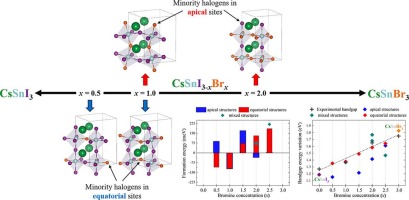当前位置:
X-MOL 学术
›
Comp. Mater. Sci.
›
论文详情
Our official English website, www.x-mol.net, welcomes your
feedback! (Note: you will need to create a separate account there.)
DFT-based study of the bulk tin mixed-halide CsSnI3-Br perovskite
Computational Materials Science ( IF 3.1 ) Pub Date : 2020-06-01 , DOI: 10.1016/j.commatsci.2020.109619 I. Ornelas-Cruz , A. Trejo , R. Oviedo-Roa , F. Salazar , E. Carvajal , A. Miranda , M. Cruz-Irisson
Computational Materials Science ( IF 3.1 ) Pub Date : 2020-06-01 , DOI: 10.1016/j.commatsci.2020.109619 I. Ornelas-Cruz , A. Trejo , R. Oviedo-Roa , F. Salazar , E. Carvajal , A. Miranda , M. Cruz-Irisson

|
Abstract Metal-halide perovskites compounds, such as CsSnX3 (X = halogen), have attracted a lot of attention as a photovoltaic material due to their astonishing optoelectronic properties, nevertheless, the improvement of its efficiency is still an issue. It has been observed that the mixing of halogens in the perovskite structure increases the compound stability. However, theoretical studies of the effects of this mixing are scarce; by understanding the most stable mixing positions it would be possible to enhance the stability of these structures, which in turn it would help to enhance the performance of a perovskite-based photovoltaic device. Thus, a Density Functional Theory study was performed on the CsSnI3-xBrx perovskite as a function of the bromine concentration (0 ≤ x ≤ 3). The distortions of the octahedral array and the energy gap of each system studied are highly dependent on the position of bromine atoms within the unit-cell. It was observed that stable compounds could be found at x = 0.5, 1.0, and 2.0 due to the strengthening of the metal-halogen bonds. These results could explain the literature-reported enhance of the performance, as a photovoltaic material, of CsSnI3-xBrx with respect to CsSnI3. Besides, non-covalent interactions between halogens and Cs atoms were found. Different energies attributed to such interactions were calculated and revealed that the off-centering of Cs atoms are driven by the countering effect of the I-(1−δ)-Sn-Br-(1+δ) polar bonds within CsSnI3-xBrx. These results give an insight of the properties of the CsSnI3-xBrx alloy and its stability which could be beneficial to the rising field of perovskite photovoltaics.
中文翻译:

基于 DFT 的大块锡混合卤化物 CsSnI3-Br 钙钛矿研究
摘要 金属卤化物钙钛矿化合物,如 CsSnX3 (X = 卤素),由于其惊人的光电性能而作为一种光伏材料引起了很多关注,但其效率的提高仍然是一个问题。已经观察到,钙钛矿结构中卤素的混合增加了化合物的稳定性。然而,关于这种混合影响的理论研究很少。通过了解最稳定的混合位置,可以提高这些结构的稳定性,进而有助于提高基于钙钛矿的光伏器件的性能。因此,对 CsSnI3-xBrx 钙钛矿作为溴浓度 (0 ≤ x ≤ 3) 的函数进行了密度泛函理论研究。八面体阵列的畸变和所研究的每个系统的能隙高度依赖于溴原子在晶胞内的位置。据观察,由于金属 - 卤素键的增强,可以在 x = 0.5、1.0 和 2.0 处找到稳定的化合物。这些结果可以解释文献报道的 CsSnI3-xBrx 作为光伏材料的性能相对于 CsSnI3 的增强。此外,还发现了卤素和 Cs 原子之间的非共价相互作用。计算了归因于这种相互作用的不同能量,并表明 Cs 原子的偏心是由 CsSnI3-xBrx 内的 I-(1-δ)-Sn-Br-(1+δ) 极性键的反作用驱动的。
更新日期:2020-06-01
中文翻译:

基于 DFT 的大块锡混合卤化物 CsSnI3-Br 钙钛矿研究
摘要 金属卤化物钙钛矿化合物,如 CsSnX3 (X = 卤素),由于其惊人的光电性能而作为一种光伏材料引起了很多关注,但其效率的提高仍然是一个问题。已经观察到,钙钛矿结构中卤素的混合增加了化合物的稳定性。然而,关于这种混合影响的理论研究很少。通过了解最稳定的混合位置,可以提高这些结构的稳定性,进而有助于提高基于钙钛矿的光伏器件的性能。因此,对 CsSnI3-xBrx 钙钛矿作为溴浓度 (0 ≤ x ≤ 3) 的函数进行了密度泛函理论研究。八面体阵列的畸变和所研究的每个系统的能隙高度依赖于溴原子在晶胞内的位置。据观察,由于金属 - 卤素键的增强,可以在 x = 0.5、1.0 和 2.0 处找到稳定的化合物。这些结果可以解释文献报道的 CsSnI3-xBrx 作为光伏材料的性能相对于 CsSnI3 的增强。此外,还发现了卤素和 Cs 原子之间的非共价相互作用。计算了归因于这种相互作用的不同能量,并表明 Cs 原子的偏心是由 CsSnI3-xBrx 内的 I-(1-δ)-Sn-Br-(1+δ) 极性键的反作用驱动的。











































 京公网安备 11010802027423号
京公网安备 11010802027423号